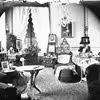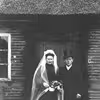The street photographer from Skamby
- on the photographer Hans Christian Brøns and his photographs
The first photographs that began to turn up in Denmark around 1840 created instantaeous excitement. The cartes de visites with a small photograph mounted on each card was a great fad, and in the early years, photographers earned a good living with the small photographs. It was a highly sought-after job, and in 1865 Copenhagen alone boasted 120 photographic studios. Competition was fierce, and in subsequent years, the number of photographers fell at the same time as the profession spread throughout the entire land. In 1898, Copenhagen had 80 studios, Aarhus 22, the other market towns together had 200, and rural municipalities had 119.
At first, the studios were scarcely furnished, but from the 1860s, the photographers equipped their studios with various painted decorations and backdrops. Primarily, daylight was used, so it was necessary to have large glass panels in the buildings. However, when electricity made its appearance at the beginning of the 20th century, electric lighting began to be used. The first flash lamps appeared in Denmark in the 1920s, but prior to that, photographers had also tried other forms of light sources.
Although portrait photography was the most sought-after form of photography, from the very outset, a significant demand for topographical shooting of famous buildings and beautiful landscapes, too, was seen. In its infancy, however, outdoor photography was associated with serious technical challenges. It was time-consuming, and costly, and the price was correspondingly high.
Many archives, among others, the Søndersø Town & Region’s Local History Archive is fortunate to have a large number of photographs taken by one of these early Danish photographers, Hans Christian Brøns (1844-1924) who worked both locally and around the entire country.
He was born on the 28th June 1844 in Lumby as the son of the school teacher Johannes Christian Brøns. He was the second of four children who grew up in the village schoolmaster’s home, until the family moved to Skamby in north Funen in 1855 where his father had found a new job as a schoolteacher.
According to family legend, Brøns’s interest in photography began in 1866, when a relative, Peter Lorents Fangel had been to Paris and brought back a stereoscope and 12 images. When in the following year he visited his family in Skamby, here too, interest for photography was sparked. Lorents Fangel made his home later on in Middelfart where for many years he successfully sold stereoscopes and pictures, but it was only in 1887 that he began as a photographer himself. And he indeed did make an impression! A considerable amount of his production, over 5,000 negatives are to be found in Middelfart Town Archives today.
At first, Brøns did not take photographs on a professional basis. The family earned its living by means of his wife’s grocery store. It was only when he formed a company with his brother-in-law, Andreas Nicolai Høeg, who lived in Skamby, and who was 9 years older than him, that he began to be very successful.
Through their company "Høeg and Brøns, Skamby nr. Odense" they produced a great many stereoscopic pictures. They produced a series from Jutland and two from Funen, each with 50 motifs. In 1873, however, when Andreas Høeg left Skamby, Brøns took over the entire photography business. Among the oeuvres from the following years, a series of pictures of Denmark and a number of photographs from Funen are known. Few of Brøns’s photos are known from after ca. 1915, and it is likely that the ageing photographer quietly cut down production. The last time he advertised was in a directory for 1916.
He spent his final years at his daughter Agnes’s home in Copenhagen until he died at St. Joseph’s Hospital on the 4th April 1924 aged almost 80.


